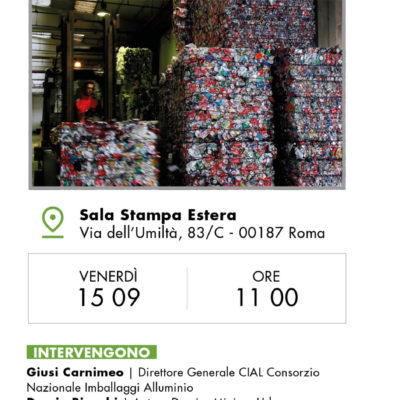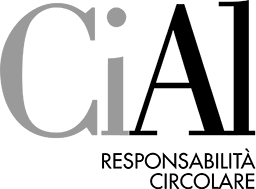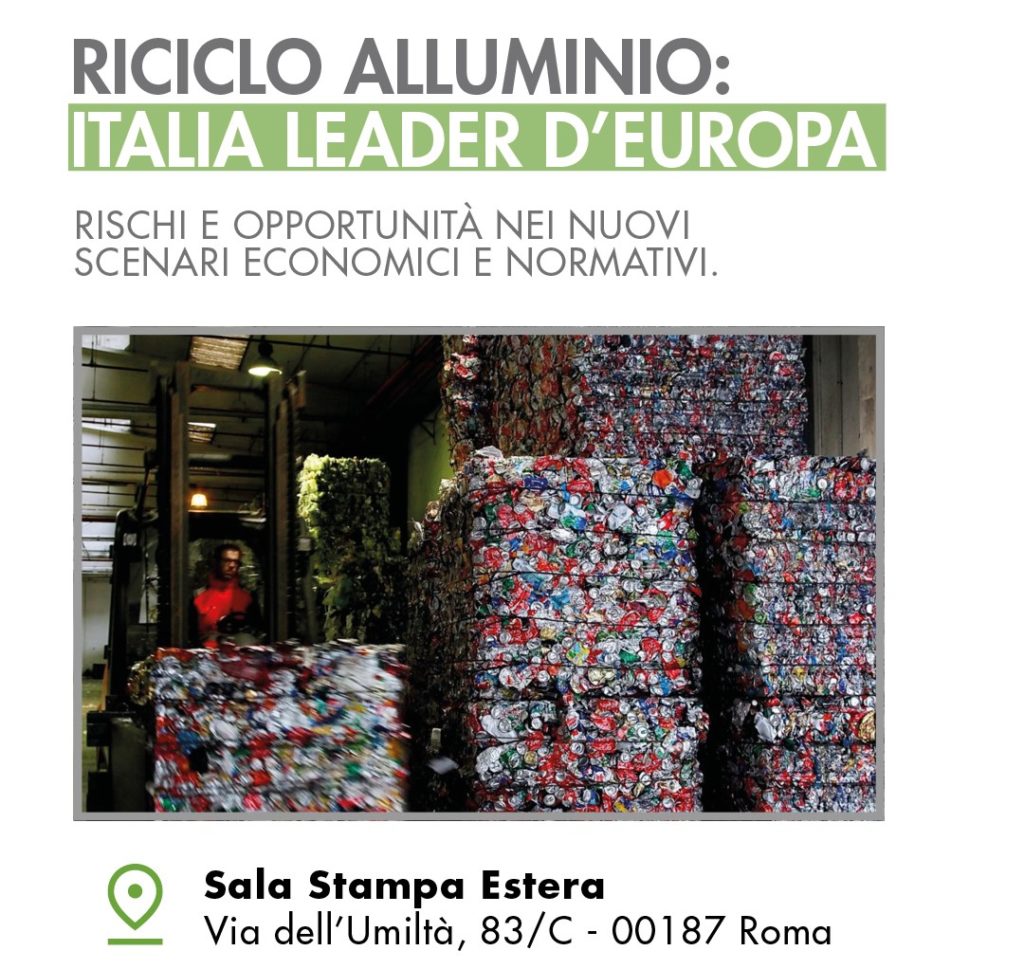100% and infinitely recyclable, aluminium is the “material sharing” par excellence, used daily in many sectors. Global estimates predict a strong increase in its use. Recycled aluminium is a fundamental stepping stone for the development of an increasingly circular economy.
Italy is a virtuous example for Europe: 100% of national aluminium production comes from recycling and as much as 73.6% of aluminium packaging is recycled – to the considerable advantage of the environment and sustainability.
Rome, headquarters of the Foreign Press Association – 15 September 2023 – Aluminium Recycling: Italy leader in Europe. Risks and opportunities in new economic and regulatory scenarios. This is the title of the conference held this morning in Rome, called by CIAL, the Italian National Aluminium Packaging Consortium. The purpose was to announce the results of the activities for the recovery of aluminium packaging that has reached the end of its life cycle (obtained from the separate waste collection carried out by individual municipalities) and to highlight the effectiveness and success of the Italian model, operational since 1997.
The meeting also provided the opportunity to present the results of the recent “Urban Mines” dossier, conducted by Duccio Bianchi, an environmental policy scholar, which highlights a strongly rising trend in the global use of both primary and recycled aluminium in the near future.
Roberta Niboli, former President of Assiral – Italian Aluminium Refiners Association, also highlighted the contribution provided to the decarbonisation process by the industry in the relevant sector.
Let us start from a fact: in Italy, in 2022, 73.6% of the aluminium packaging placed on the market was sent for recycling (i.e. 60,200 tons): this goal has allowed Italy to significantly exceed the community objectives set for 2025 (50%) and 2030 (60%) well before time.
The efficiency of the Italian system is even more evident if analysing the breakdown of the recycling rate for aluminium beverage cans alone, which was 91.6% in 2022. A record result, in line with that of countries with systems based on security deposits and far superior to the average European recycling rate, which is currently 73%.

“Aluminium is material sharing par excellence,” begins Giusi Carnimeo, General Manager of CIAL. “One of two things will happen to a product at the end of its life cycle. Either it is decommissioned and subsequently disposed of, or – if possible – it is sent for recovery and then recycled or re-used. From this point of view, aluminium is a material with extraordinary intrinsic characteristics. Used to make millions of products, it is 100% and infinitely recyclable. It maintains its structural properties forever. Suffice it to say that over 75% of the aluminium that was ever produced is still being used.”
“CIAL has always been the spokesperson for an evolved concept of sustainability, based on the active cooperation of all the actors involved in the supply chain, from businesses, to public administration, to citizens, so that they contribute to achieving the most challenging goals in modern models of production, consumption and recycling. It is a question of circular responsibility.
Italy is a particularly virtuous example: 100% of Italian aluminium production comes from recycling. In terms of “being green”, this is no mean feat. The production of aluminium by recycling scrap compared to primary production allows for energy savings of around 95% and avoids greenhouse emissions equal to 423 thousand tonnes of CO2.
Furthermore, thanks to the lightness of the material, aluminium packaging accounts for only 0.5% of the weight
of the total packaging placed on the market. This translates into about 81,800 tonnes (cans, trays, boxes, spray cans, tubes, thin foil, etc.) out of a total of over 14,500,000 tonnes overall of the six main packaging materials. This is because, over the last 20 years, one of the main environmentally friendly features of the global aluminium packaging sector has been its constant evolution aimed at reducing thickness and consequently weight (measurable in grams). An example can effectively help understand this. Thanks to research, the weight of a 33 cl beverage can has gone from 14g in 2000 to the current 12.2g, a 12% reduction. In terms of environmental protection, these are “very heavy” grams which, multiplied by the millions of cans produced each year, transform into tons saved in the production phase.
A new EU Regulation, poised between risks and opportunities – In November 2022, the European Commission presented a proposal for a Regulation, known as PPWR (Packaging and Packaging Waste Regulation), which contains new operational parameters and new objectives regarding packaging and disposal of packaging waste. The objective is to increase the “circularity” of products by focusing on reusing packaging rather than recycling it.
“While we agree with the aim of preventing the generation of packaging waste, we are concerned that re-use objectives, particularly those for food and drink, lack solid scientific analysis on a product-by-product basis. We believe that the most balanced and suitable approach to optimise the environmental sustainability of the use of packaging is to allow Member States to choose and balance, on a case-by-case basis, the best solution between reusing and/or recycling while maintaining the main objective of the Regulation and the vocation – including infrastructural – of individual Member States. The objectives of the PPWR are obviously acceptable. However, it is not a question of purpose, but of method. Recycling, the foundation of our national waste management system for 25 years now, has made it possible to achieve excellent results in Italy,” concludes Giusi Carnimeo.
In Italy, priority is given to quality recycling through separate waste collection which, for more than 25 years, has included all types of aluminium packaging, not just the types that are most profitable and easy to collect. This is the difference between the so-called “closing loop”, where a single type of packaging is selectively collected and recycled to obtain the same product, and the “metal-to-metal loop”, which characterises the Italian model and which involves the collection and maximisation of the recovery of all types of packaging, and an expanded (re)use of recycled aluminium, without application limits.
The proposed Regulation, in its current form, imposes solutions that do not take into account the paths already taken, often with excellent results, by individual States. In the case of Italy, not only has the entire system, which involves businesses, workers and technologies, been successfully built on recycling, but it has so far achieved the recycling objectives for individual packaging materials years before the dates set in the current European regulations issued in directive form.
A “treasure” for the ecological transition – Duccio Bianchi, consultant and researcher in environmental planning and waste management, author of the recently published “Urban Mines” dossier, predicts that “by 2030, global demand for aluminium will increase by almost 40%, rising from the current 86.2 Mt to 119.5 Mt. And this growth will be largely driven by the ecological transition. For example, in the automotive sector and more generally in transport, the now unstoppable electrification process will lead to an increasing use of aluminium components. At the same time, the development of photovoltaics will determine an additional demand for aluminium equal to approximately 10 million tonnes per year, considering that solar panels are 88% aluminium.”
Bianchi’s study also highlights that in Europe as much as 79% of post-consumer aluminium is recycled (it was 65% in 2005) and that almost all pre-consumer waste is recycled.
But a global increase in recycled aluminium is still highly desirable. Also for environmental reasons. It is important to remember that the production of primary aluminium has a significant environmental impact. While producing one ton of secondary aluminium generates 0.5 tons of CO2 emissions, the world average for the production of one ton of primary aluminium is approximately 17 tons of CO2 (i.e. 34 times that of secondary aluminium).
Italy is a leader in the production of recycled aluminium – Our country is the leading European producer of recycled aluminium, both in terms of production quantity and in terms of scrap used. In 2021, the national production of secondary aluminium reached an all-time high with 954 thousand tons produced. But the road can still be improved by increasing the overall mass of the material collected and reducing “material losses”. The study highlights that, considering the potential presence of around 167 thousand tons of aluminium in urban waste, around 65 thousand tons are “lost” – apparently not recycled or recovered – which is just under 40% of the total aluminium.
It is above all in the “bulky waste” segment that there is the greatest room for improvement . “Suffice it to say that, from the management of bulky waste (which accounts for around 60 thousand tons of aluminium), less than 1,500 tons of aluminium are recovered today due to the absence (or improper management) of non-ferrous metal capture devices,” concludes Duccio Bianchi.
The contribution of the aluminium industry to decarbonisation – As regards the sector of aluminium coming from refining, Italy has been leading in Europe for over 10 years (excluding the 2017-2018 two-year period). Italy produces 717 thousand tons (compared to 473 thousand in Germany and 300 thousand in Spain). This is the first piece of data highlighted by Roberta Niboli, Former President of Assiral, the Italian Association of Aluminium Refiners.
From an environmental perspective, this piece of data is important, given that recycled aluminium requires 95% less energy than primary bauxite aluminium.
Transport is the main destination sector for aluminium alloys (70%), followed by the mechanics (12%), electromechanics (8%) and construction (7.5%) sectors. With further weight reduction requirements, the push towards electrification and the increasing number of larger, higher-end vehicles, aluminium content in vehicles will increase in the coming years. Just as it will increase in many other sectors. It is therefore clear that aluminium scrap represents a crucial energy bank. It is necessary to limit its export precisely to avoid the loss of a raw material that can be easily recovered and reused to create aluminium, with a much lower energy expenditure than producing it from scratch. The equation is simple: if we export scrap we lose energy, and also raw material than can be used to feed the entire European manufacturing chain.
“If the purpose of the CBAM – Carbon Border Adjustment Mechanism (which provides for a carbon tax on some imported products) is to protect the European industry, there is the risk that Europe, which is strongly dependant on primary aluminium from bauxite from non-EU countries, will be paying additional costs to import material that we need anyway. It will be important, at a European level, to both increase the recycling percentage and to have access to primary aluminium and other raw materials at costs that allow us to compete on a global level,” concludes Roberta Niboli.
————————
CIAL – The National Consortium for Aluminium Packaging was founded in 1997 to foster the recycling and recovery of aluminium packaging at the end of its life cycle through separate waste collection by municipalities. The goal is to contribute to the recovery of a precious raw material, avoiding waste and protecting the environment. In this way, beverage cans, tins, trays, spray cans and thin aluminium sheet become fundamental and essential resources for sustainable and clean economic growth, just like the Italian recycling industry, which ranks among the top achievers in the world for its influential environmental performance. Respect for the environment, elimination of landfills and economic valorisation of reusable resources: these are some of the reasons why CIAL has been operating for 25 years in Italy, for and on behalf of the companies in the consortium (producers and users of aluminium packaging, and recovery and recycling enterprises), promoting collection and recovery and raising awareness among millions of citizens in collaboration with public administrations.
ASSIRAL – The Italian Aluminium Refiners Association, established in 1972, brings together the main producers of recycled aluminium that, by applying the best technologies, process scrap and give new life to the aluminium itself, in a closed loop which represents one of the pillars of the Circular Economy. Assiral members are included in the great Italian and European aluminium value chain, bringing the Italian recycling sector to the top of European production.

